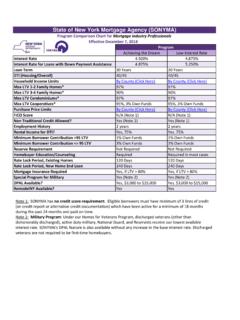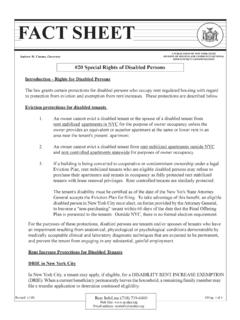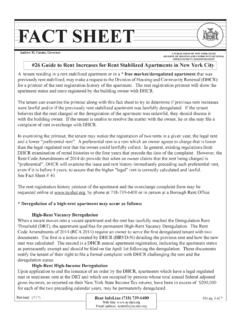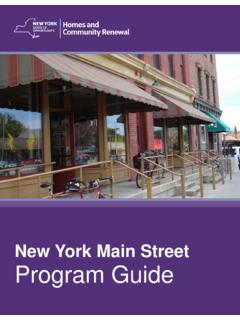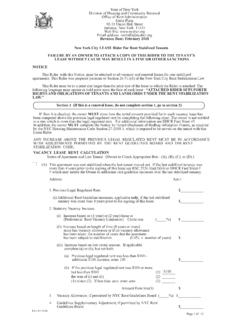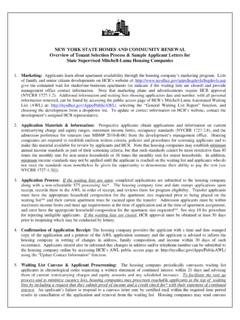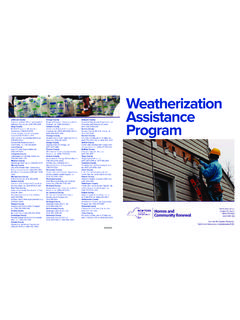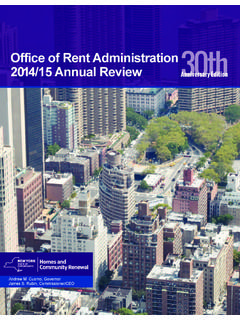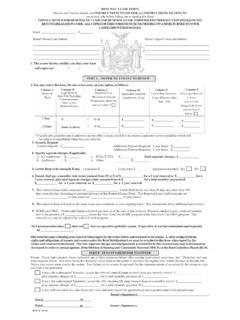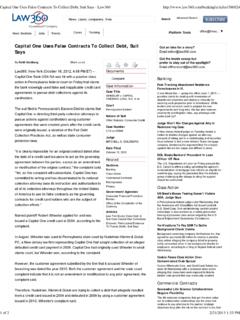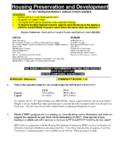Transcription of STATE OF NEW YORK ACTION PLAN FOR …
1 STATE OF NEW york ACTION PLAN FOR COMMUNITY DEVELOPMENT BLOCK GRANT PROGRAM DISASTER RECOVERY Utilizing Supplemental CDBG Disaster Recovery Funding from the Allocation, Common Application, Waivers, and Alternative Requirements for Community Development Block Grant Disaster Recovery Grantees Under the Department of Housing and Urban Development Appropriations Act, 2013 (Public Law 113-2) Through the US Department of Housing and Urban Development Office of the Assistant Secretary for Community Planning and Development Federal Register Docket No. FR-5696-N-01 Andrew M. Cuomo, Governor, NYS Darryl C. Towns, Commissioner/CEO, NYS HCR Prepared by New york STATE Homes and Community Renewal Office of Community Renewal April, 2013 New york STATE Office of Community Renewal CDBG-DR ACTION Plan Table of Contents 1. Introduction .. 1 2. Needs Assessment and Rationale for Prioritization of Funds .. 4 A. Housing .. 5 B. Economic Impact.
2 29 C. Infrastructure .. 34 3. Proposed Use of Funds .. 37 A. Housing .. 38 B. Economic Development .. 48 C. Resilience and Retrofit .. 53 D. Community Planning and Redevelopment .. 55 E. Public Infrastructure and Facilities and Local Government Support .. 59 F. Infrastructure Bank .. 61 4. Eligible & Ineligible Activities .. 64 5. STATE and Local General Administration .. 70 A. Eligible Administrative Costs: .. 71 B. Eligible Program Delivery Costs:.. 72 6. Promoting high quality durable, energy efficient and mold resistant construction methods .. 74 7. Provision of adequate, flood resistant housing for all income groups that lived in the disaster impacted areas .. 75 8. Method of Allocation .. 76 9. Tracking and Reporting of Program Performance .. 78 10. Proposed Distribution of 79 11. Development of the Proposed Disaster Recovery 81 12. Amendments to the Disaster Recovery Plan .. 82 13. New york STATE Citizen Participation.
3 83 A. Citizen Participation Requirements for Local Governments Participating in the CDBG-DR Program .. 84 B. Performance Hearings .. 84 C. Complaint Procedures .. 85 14. Overview of Allocations and Program Delivery .. 86 15. Project 87 16. Avoidance & Mitigation of Occurrences of Fraud, 88 & Mismanagement .. 88 17. Public Comments Received .. 98 18. Contact Information .. 109 Persons with disabilities or non-English speakers who may need these documents presented in a different format are encouraged to contact New york STATE Homes and Community Renewal who will provide the document in an accessible format. 1-866-ASK-DHCR (1-866-275-3427) April 25, 2013 Page 1 1. Introduction In late October 2012, the largest storm in New york s recorded history swept ashore. Hurricane Sandy s effect was devastating, causing widespread damage to lives, homes, businesses, core infrastructure, government property and an economy just recovering from the financial crisis.
4 Fourteen counties were declared as Federal disaster areas. Sixty New Yorkers died and two million customers lost power with some blackouts lasting up to three weeks. The storm damaged or destroyed as many as 300,000 housing units, affected or closed over 2,000 miles of roads, produced catastrophic flooding in subways and tunnels, and damaged major power transmission systems. Hurricane Sandy s impact was particularly tragic coming on the heels of Hurricane Irene and Tropical Storm Lee, which in 2011 devastated many communities in Upstate New york and the Hudson Valley region, as well as on Long Island. Tens of thousands of homes incurred damage in these storms, many of them destroyed by flood waters and wind. Businesses and infrastructure suffered substantial damage as well. Communities affected by these storms are still working hard every day to build back their lives. In response to Hurricane Sandy, Hurricane Irene and Tropical Storm Lee, New york STATE has developed a Storm Recovery Plan to help define how the STATE will effectively use all available funding to recover and rebuild, and just as importantly, to stimulate economic growth in every affected community.
5 That plan encompasses the full range of critical recovery and rebuilding, including transportation and energy infrastructure, coastal protections and natural infrastructure, water treatment plants, housing, business recovery, and many others. On Tuesday, March 5, 2013, the Department of Housing and Urban Development (HUD) published Federal Register Notice 5696-N-01, which established the requirements and processes for the first $ billion in Federal CDBG-DR aid appropriated by the United states Congress, and allocated to New york STATE , for disaster relief. This document, the STATE s required CDBG-DR ACTION Plan, addresses exclusively one portion of the STATE s Storm Recovery Plan; the STATE s proposed use of the first allocation of these CDBG-DR funds to New york STATE . Using this first allocation, the STATE will focus principally on meeting the immediate needs for housing and business assistance in the communities affected by recent storms; assisting county and local governments to cover both their emergency expenses and the matching fund requirements that must be met to repair and mitigate key infrastructure projects; and, by leveraging private financing, assisting critical facilities that suffered damage to install energy-related mitigation ( , combined heat and power systems) to withstand future natural disasters.
6 The STATE will use later allocations not only to continue to address these needs, but also to fund critical infrastructure repair and mitigation and community-driven plans to improve resilience and economic growth. April 25, 2013 Page 2 HUD allocated the first one-third of these CDBG-DR funds based on its estimate of the most critical unmet needs for severe damage to businesses, infrastructure and housing that remain to be addressed in the most impacted states and counties, after taking into account data on insurance, Federal Emergency Management Agency (FEMA) assistance, and Small Business Administration (SBA) disaster loans. Per this evaluation, New york STATE Homes and Community Renewal (NYS HCR), through its Office of Community Renewal (OCR) and the Housing Trust Fund Corporation (HTFC), will oversee the administration of approximately $ billion to assist impacted communities with disaster recovery.
7 NYS HCR consists of all the STATE s major housing and community renewal agencies, including the STATE of New york Mortgage Agency, the Affordable Housing Corporation, the Division of Housing and Community Renewal, the Housing Finance Agency, the Housing Trust Fund Corporation and others. In addition to the STATE s allocation, New york City will receive approximately $ billion of CDBG-DR funding to administer directly. The STATE of New york is required to publish an ACTION Plan for Disaster Recovery that describes the proposed use of HUD CDBG-DR funding as provided under the Allocation, Common Application, Waivers, and Alternative Requirements for Grantees Receiving Community Development Block Grant Disaster Recovery (CDBG-DR) Funds in Response to Hurricane Sandy. Under Federal Law, the ACTION Plan must describe: How the proposed use of CDBG-DR funds will address long-term recovery needs; Eligible affected areas and the distribution of CDBG-DR funds to those areas; Activities for which CDBG-DR funds may be used; The Citizen Participation process used to develop the ACTION Plan; and Grant administration standards.
8 The overall ACTION Plan will be used as a guide by the STATE of New york and the OCR for the distribution of $1,713,960,000 of CDBG-DR funding to meet the unmet housing, economic development, community planning, and infrastructure needs of impacted communities. As outlined in the Federal Register Notice a minimum of 80%, or $1,371,168,000 of the STATE s allocation, must be expended in the most impacted Counties, identified by HUD as Nassau, Suffolk, Westchester, and Rockland. The use of the first tranche of these funds, as outlined in the Federal Register Notice, will also be used to address remaining unmet needs in declared counties impacted by Hurricane Sandy, Hurricane Irene and Tropical Storm Lee. At this time, New york STATE is submitting a comprehensive ACTION Plan proposal for the use of the first $ billion allocation to the STATE , but intends to pursue incremental obligation of its allocation, as agreed to in consultation with HUD, in order to control the expenditure and delivery of these funds in the most efficient and effective manner.
9 The ACTION Plan proposal that follows contains a preliminary assessment of the STATE s needs, but as the STATE continues to identify the full scope of needs and programs require April 25, 2013 Page 3 additional funding the STATE will seek additional funds from this allocation to support those programs. April 25, 2013 Page 4 2. Needs Assessment and Rationale for Prioritization of Funds In response to Hurricane Sandy, Hurricane Irene and Tropical Storm Lee, New york STATE has developed a Storm Recovery Plan to help define how the STATE will effectively use any available funding to recover and rebuild, and just as importantly, to stimulate economic growth in every affected community through a community-driven planning process. The plan is based on six key principles: 1. Building back better and smarter As New Yorkers repair the significant damage wrought by Hurricane Sandy, the STATE will use the opportunity not to replace damaged buildings with the same structures, but to invest in additional mitigation to prevent similar damage from recurring.
10 2. STATE -led, community-driven recovery The STATE is collaborating closely with local governments and other organizations to ensure a coordinated and holistic response, while looking to individual communities to develop forward-looking local recovery plans that meet their specific needs. 3. Recovery from Irene and Lee The recovery efforts will also extend to those communities still recovering from Hurricane Irene and Tropical Storm Lee. 4. Leveraging private dollars The STATE will undertake programs that will help unlock capital markets and increase the amount of low-interest financing of key projects by reducing the risk for private sector lenders. 5. Spending accountability and transparency - To make certain that funds are spent appropriately and responsibly, the STATE will put rigorous spending accountability systems in place and employ an independent auditing firm.
